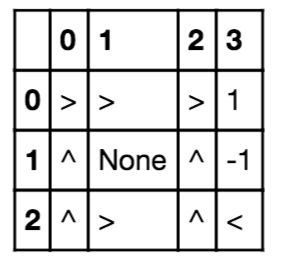pythonで強化学習を試す
強化学習が巷でブームになっておりますが、私もpython 初心者ながらこれについて手探りながら勉強しています。
その中でとても参考になったのが以下のHironsanさんの記事。
強化学習についての説明はとてもわかりやすかったのですが、実際の記事に記載してあるコードや引用元のUC Berkeleyの中身をみてもメソッドの一部が欠けていたので、自分でコード補完して動かしてみました。 コードは以下、
import random import operator, math, random, copy, sys, os.path, bisect import pandas as pd def print_table(table, header=None, sep=' ', numfmt='%g'): justs = [if_(isnumber(x), 'rjust', 'ljust') for x in table[0]] if header: table = [header] + table table = [[if_(isnumber(x), lambda: numfmt % x, x) for x in row] for row in table] maxlen = lambda seq: max(map(len, seq)) sizes = map(maxlen, zip(*[map(str, row) for row in table])) def argmin(seq, fn): best = seq[0]; best_score = fn(best) for x in seq: x_score = fn(x) if x_score < best_score: best, best_score = x, x_score return best def argmax(seq, fn): return argmin(seq, lambda x: -fn(x)) def vector_add(a, b): return tuple(map(operator.add, a, b)) orientations = [(1,0), (0, 1), (-1, 0), (0, -1)] def turn_right(orientation): return orientations[orientations.index(orientation)-1] def turn_left(orientation): return orientations[(orientations.index(orientation)+1) % len(orientations)] import random class MDP: def __init__(self, init, actlist, terminals, gamma=.9): self.init = init self.actlist = actlist self.terminals = terminals if not (0 <= gamma < 1): raise ValueError("An MDP must have 0 <= gamma < 1") self.gamma = gamma self.states = set() self.reward = {} def R(self, state): return self.reward[state] def T(self, state, action): raise NotImplementedError def actions(self, state): if state in self.terminals: return [None] else: return self.actlist class GridMDP(MDP): def __init__(self, grid, terminals, init=(0, 0), gamma=.9): grid.reverse() # because we want row 0 on bottom, not on top MDP.__init__(self, init, actlist=orientations, terminals=terminals, gamma=gamma) self.grid = grid self.rows = len(grid) self.cols = len(grid[0]) for x in range(self.cols): for y in range(self.rows): self.reward[x, y] = grid[y][x] if grid[y][x] is not None: self.states.add((x, y)) def T(self, state, action): if action is None: return [(0.0, state)] else: return [(0.8, self.go(state, action)), (0.1, self.go(state, turn_right(action))), (0.1, self.go(state, turn_left(action)))] def go(self, state, direction): state1 = vector_add(state, direction) return state1 if state1 in self.states else state def to_grid(self, mapping): return list(reversed([[mapping.get((x, y), None) for x in range(self.cols)] for y in range(self.rows)])) def to_arrows(self, policy,U): arrows_result={} chars = { (1, 0): '>', (0, 1): '^', (-1, 0): '<', (0, -1): 'v', None: '.'} for(s,a)in policy.items(): if policy[s] == None: arrows_result[s] = U[s] else: arrows_result[s]=chars[a] return self.to_grid(arrows_result) # ______________________________________________________________________________ sequential_decision_environment = GridMDP([[-0.04, -0.04, -0.04, +1], [-0.04, None, -0.04, -1], [-0.04, -0.04, -0.04, -0.04]], terminals=[(3, 2), (3, 1)]) # ______________________________________________________________________________ # ______________________________________________________________________________ sequential_decision_environment2 = GridMDP([[-1, -0.04, -0.04, -0.04,+1], [-0.04, -0.04, None,-0.04, -0.04], [-0.04, None, -0.04, -0.04,0.04], [-0.04, -0.04, -0.04,-0.04, -0.04]], terminals=[(4, 3), (0, 3)]) # ______________________________________________________________________________ def value_iteration(mdp, epsilon=0.001): U1 = {s: 0 for s in mdp.states} R, T, gamma = mdp.R, mdp.T, mdp.gamma while True: U = U1.copy() delta = 0 for s in mdp.states: U1[s] = R(s) + gamma * max([sum([p * U[s1] for (p, s1) in T(s, a)]) for a in mdp.actions(s)]) delta = max(delta, abs(U1[s] - U[s])) if delta < epsilon * (1 - gamma) / gamma: return U def best_policy(mdp, U): pi = {} for s in mdp.states: pi[s] = argmax(mdp.actions(s), lambda a: expected_utility(a, s, U, mdp)) return pi, U def expected_utility(a, s, U, mdp): return sum([p * U[s1] for (p, s1) in mdp.T(s, a)]) # ______________________________________________________________________________ def policy_iteration(mdp): U = {s: 0 for s in mdp.states} pi = {s: random.choice(mdp.actions(s)) for s in mdp.states} while True: U = policy_evaluation(pi, U, mdp) unchanged = True for s in mdp.states: a = argmax(mdp.actions(s), key=lambda a: expected_utility(a, s, U, mdp)) if a != pi[s]: pi[s] = a unchanged = False if unchanged: return pi[f:id:tachiken0210:20170529202347p:plain] def policy_evaluation(pi, U, mdp, k=20): R, T, gamma = mdp.R, mdp.T, mdp.gamma for i in range(k): for s in mdp.states: U[s] = R(s) + gamma * sum([p * U[s1] for (p, s1) in T(s, pi[s])]) return U pi ,U= best_policy(sequential_decision_environment, value_iteration(sequential_decision_environment, .01)) pd.DataFrame(sequential_decision_environment.to_arrows(pi,U))
実行すると結果は以下のように

行と列や中身を変更
